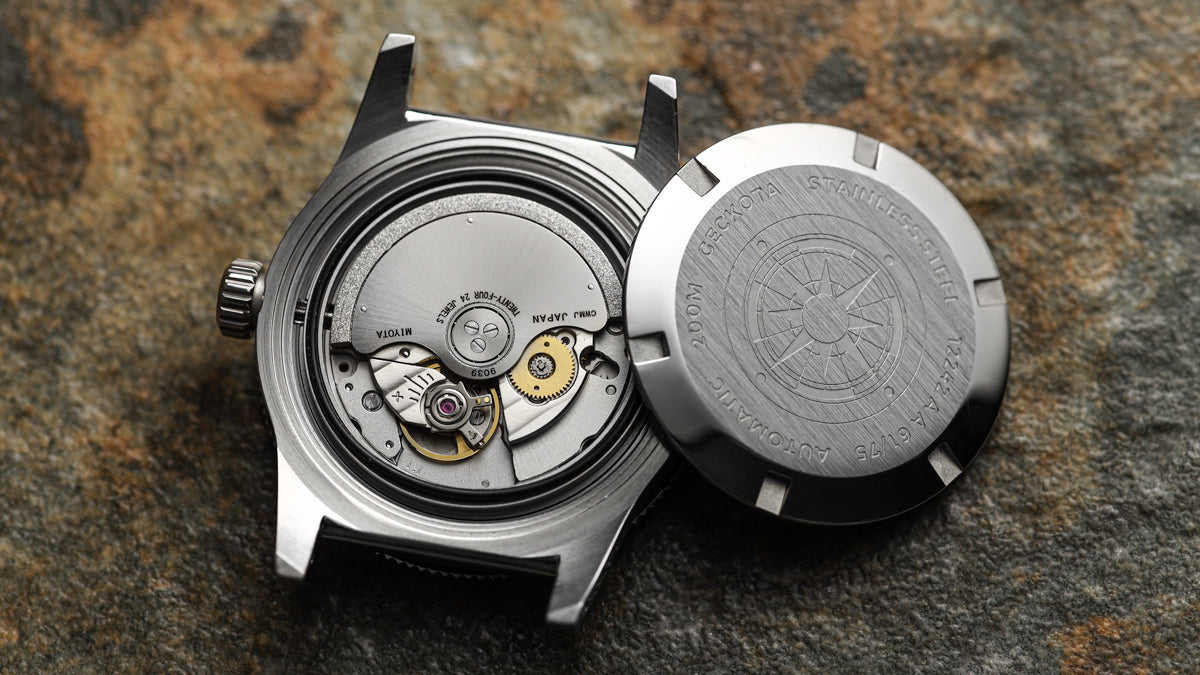
December 04, 2023 4 min read
In a world dominated by smart watches and digital screens, here at Geckota, we’ll never tire of the craftsmanship and artistry that goes into the creation of mechanical, automatic winding watches. These fascinating devices are more than just timekeepers but works of art that embody a watchmaker’s creativity and prowess.
Whether you’re a seasoned watch collector or a newcomer to the world of horology, we’re sure you’ve looked at a timepiece and wondered how it works. What fuels those tiny mechanisms sometimes displayed through a watch’s case back? How does the motion of the hands and other complications stay powered? We’re about to explain it all…
 GECKOTA PIONEER AURORA AUTOMATIC WATCH PURPLE SUNBURST
GECKOTA PIONEER AURORA AUTOMATIC WATCH PURPLE SUNBURST
Watches are often split into two categories: quartz and mechanical. Quartz watches are those affordable, easy-to-service watches powered by a battery. They’ll continue to keep the dial ticking typically for around 2-3 years before needing to have the battery changed.
Mechanical watches, on the other hand, operate without the use of any battery. Instead, they rely on a series of precisely crafted mechanical components like a mainspring, gears, balance wheel and oscillating rotor. There are two types of mechanical watches: manual winding and automatic winding.
Automatic and manual winding watches both use a number of intricate components to fuel the watch and it’s set of complications. They differ primarily in how they are powered and wound.
Manual-winding watches require the wearer to wind the mainspring by turning the crown. How often this needs to be done depends on the watch’s power reserve, but most manual-winding watch wearers will typically wind their watch every morning or every couple of days. Due to the tactile connection between the wearer and the watch, many enthusiasts appreciate the ritual of daily winding.
Automatic watches, also sometimes referred to as self-winding watches, do not need to be manually wound to work. Instead, they have an additional component called an oscillating rotor which moves with the motion of the wearer’s wrist. This rotor automatically winds the mainspring which in turn fuels the functions of the watch. Automatic watches can still be manually wound should they be left off the wrist for several days at a time, but often, just a simple shake of the rotor will get the timepiece back up and running. These types of timepieces are more convenient for individuals who wear their watch regularly.
 GECKOTA OCEAN-SCOUT DIVE WATCH
GECKOTA OCEAN-SCOUT DIVE WATCH
An automatic watch works by harnessing the motion of the wearer’s wrist to power the hundreds of tiny components inside the case. Each of the components have their own individual job, connecting to the next, to ensure the smooth running of the timepiece. Here’s a run-down of some of the most important components of an automatic watch and how they work to fuel the hands on the dial.
 GECKOTA PIONEER AUTOMATIC WATCH BLUE ARCTIC EDITION
GECKOTA PIONEER AUTOMATIC WATCH BLUE ARCTIC EDITION
A watch’s power reserve refers to the amount of time the movement can continue running after it has been fully wound. An automatic watch is fully wound when the rotor has rotated enough to wind the coil of the mainspring tightly to its limit. Most watches have a power reserve of around 38 to 42 hours, and this would be the length of time you’d be able to take your automatic watch off your wrist, before it would stop running and need winding again.
There are several ways you can wind an automatic watch. The first, and most obvious way, is by wearing it. As you wear the timepiece, the oscillating rotor in the back will naturally spin with every movement creating energy which fuels the movement. Alternatively, you can manually wind many automatic movements by turning the crown.
Another way to keep your automatic watch wound is by utilising a watch winder. These ingenious devices allow you to place one or more watches inside and mimic the natural movement of a wrist. This in turn winds the mainspring and keeps the watch fuelled, meaning even when it’s not worn, the watch will continue running.
If you want to keep your automatic watch running accurately and smoothly over the long term, servicing it on a regularly basis is an important thing to keep in mind. Many watchmakers will advise you on how often you should get your automatic watch serviced, but these recommendations typically range from around 3 to 5 years.
How often you wear your automatic watch can also affect the service interval. If you wear your watch daily, it may require less frequent servicing as the movement will be kept lubricated and in good condition. However, automatic watches stored away with less use may need extra care. A watch’s age will also play a part in how often it needs servicing. Older movements are more likely to have deteriorated components that need replacing.
So, there you have it, all you need to know about automatic watches. Has this tempted you to buy an automatic watch for yourself from our extensive range of Geckota automatic watches? Or do you already own one? If so, let us know your favourites in the comments below.

About the Author: Jon Quinn
About the Author: Jon Quinn
I’m Jonathan Quinn, founder and owner of Geckota. What excites me is what excited me when I started the business – offering high-quality watches and straps that I couldn’t find elsewhere, and seeing the pleasure they give our customers around the world.
More Articles by Jon Quinn